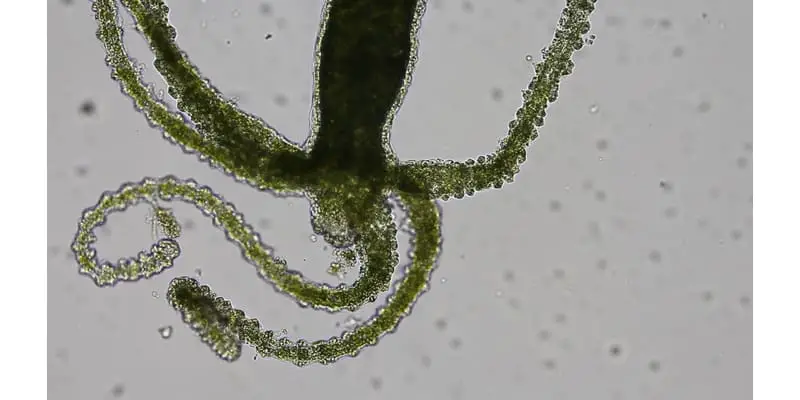The world as seen under a microscope is home to a diverse ecosystem of tiny creatures. Hydra live amongst this microscopic environment and are thought to be early ancestors of corals and jellyfish.
Hydra are multicellular predatory organisms that can grow up to 30 millimeters, which is barely visible to the naked eye. As members of the phylum Cnidaria, hydra distinctly have tentacles and a single tubular opening. There are about 30 species of these radially symmetric beings which live in freshwater environments.
This article will explore the many characteristics that make hydra so unique. The intent is to paint a clear picture of this organism and its environment so that you can better understand its behaviors and importance when observing them under a microscope.
Hydra Structure
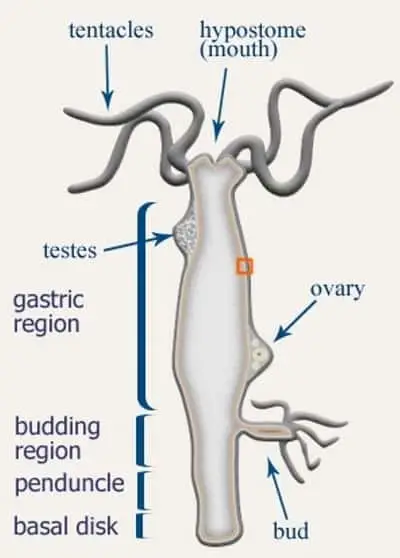
A hydra can be broken up into five segments from top to bottom:
- Hypostome: The hypostome consists of the mouth/anus opening, which is surrounded by a ring of tentacles. Tentacles are lined with small stingers called nematocysts.
- Gastric Region: The gastric region is the tubular region of the hydra’s body. It is made up of a hollow cylinder. This region, also known as the coelenteron, is a hollow tube that is responsible for the gastrovascular activity.
- Budding Region: The budding region responsible for asexual budding.
- Penduncle: Although mostly sessile, the penduncle is a stalk of tissue that gives the hydra flexibility and limited mobility.
- Basal Disk: The basal disk is flattened and secretes an adhesive that allows for the hydra to attach to hard surfaces. It is also capable of producing small air bubbles that help the hydra float.
The body wall of a hydra can be broken down into three main segments from inside to out:
- Endoderm: The endoderm consists of the gastrodermis, which is responsible for digestion.
- Mesoglea: The mesoglea acts as the supportive layer. It’s a protein-rich and gelatinous layer of connective tissue.
- Ectoderm: The ectoderm consists of a net-like nerve structure, sensory cells that send and receive messages, and germ cells that can ultimately form into male or female organs.
How Are Hydra Classified?
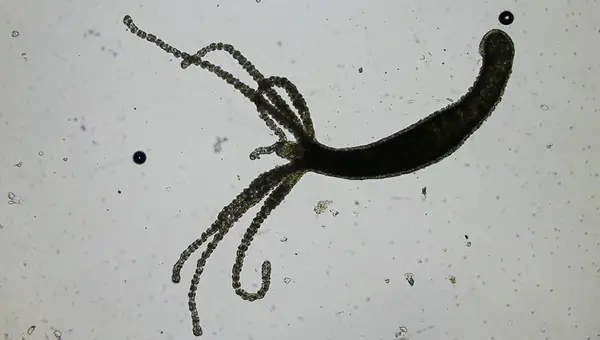
The hydra’s kingdom, phylum, class, order, and genus of the hydra are described below:
- Kingdom: Animalia – The Animalia kingdom, otherwise known as the Metazoa, encompasses all multicellular, eukaryotic animals that are heterotrophic by nature. Heterotrophic meaning that they ingest other organisms or material for nutrition.
- Phylum: Cnidaria – Cnidaria phylum is composed of approximately 11,000 species of aquatic animals that can be found in either freshwater or saltwater. They are uniquely characterized by their radial symmetry and cnidocytes, which are specialized cells used to capture prey. Cnidocytes are explosive cells that project to deliver a sting to the prey.
Other unique characteristics of the Cnidaria phylum include the presence of tentacles, just one body opening, and a body that consists of two layers. Cnidaria have a simple net-like nervous system and are planktonic as a larva. Most notably, the Cnidaria phylum consists of medusa, anemones, corals, and jellyfish.
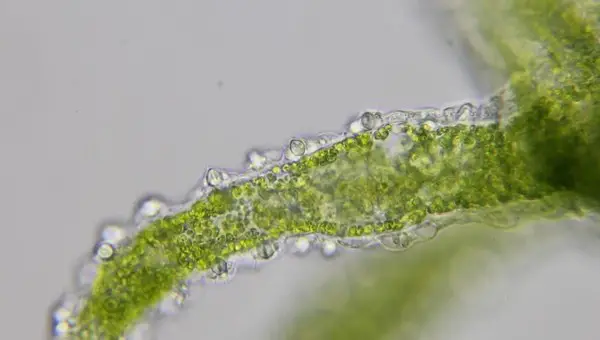
- Class: Hydrozoa – The taxonomic class Hydrozoa consist of seven orders that encompass 2,700 species. Hydrozoa are all very small in size, predatory, and are found in two body forms; either a polyp or a medusa. Their exoskeleton is made of chitin and they digest their food in their gastrovascular cavity.
- Order: Hydroida – As the largest order of Hydrozoa, the Hydroida are identified by their well-developed medusoid reproductive structures.
- Genus: Hydra – A polyp-like organism with a tubular body. Hydra are a large genus of microorganisms that have many distinguishing characteristics. It’s important to note that hydra are one of the few freshwater aquatic organisms in their lineage.
What do Hydra Eat?
Hydra are predatory creatures that need to hunt food in order to produce energy. They eat worms, larva, and other tiny invertebrates to sustain themselves. Their diet is thought to be strictly carnivorous, meaning they only feed on other animals and never feast on aquatic vegetation.
When studied, the predators appear to be picky eaters. Small hydra have been observed to strictly consume larval prey such as copepods and cladocerans. Large hydra do not waste their time with larval prey and stick to eating strictly adult copepods. This behavior demonstrates that hydra are extremely efficient hunters, only exerting energy on prey that is worth the hunt from a nutritional standpoint.
Other animals such as small crustaceans, water fleas, and shrimp are also on the menu. Hydra can consume other organisms up to the same size that they are. They have not been observed consuming animals larger than their own size.
How do Hydra Hunt?
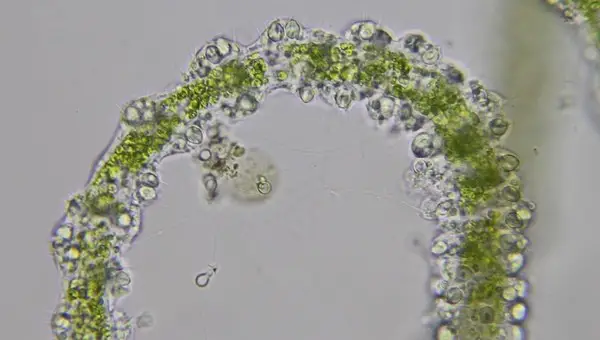
Hydra are mostly sessile, meaning that spend most of their lives attached to a surface but can detach to switch locations if need be with the help of their tentacles. This means that the hydra’s prey must be within reach of its tentacles. Thankfully, a hydra can extend its tentacles anywhere from 5 millimeters to 20 millimeters.
The body of the hydra contracts and then quickly expands with a prey in its crosshairs. This body movement is known as a contraction burst. Additionally, a hydra is capable of swaying back and forth thanks to a pacemaker near its base.
Since the Hydra only has one opening, the hole acts as both its anus and mouth. The opening has a ring of tentacles surrounding it. These tentacles are covered in stinging cells called nematocysts. Nematocysts act as both the hydra’s weapon and defense mechanism. The coiled nematocysts layer the hydra’s tentacles. When a prey bumps into a tentacle, the coiled nematocysts shoot out and deliver their toxin.
Although generally too small to be considered harmful to humans, nematocysts have been known to incapacitate or kill small fish. Each nematocyst, much like a bee’s stinger, can only be used once. Unlike a bee, thanks to the hydra’s regenerative properties, the nematocysts typically grow back within two days. Once a nematocyst’s toxins set in, the tentacles of the hydra wrap around its prey and slowly begin to work the meal towards its mouth and into its gastrovascular cavity.
As mentioned earlier, a hydra is made up of two layers. The inner layer, or the endoderm, lines the gastrovascular cavity and produces enzymes that help digest the food. Anything that is left undigested will be discarded back through the mouth/anus.
Where do Hydra Live?
Hydra live in freshwater environments in both flowing water and standing water. They are a particularly tolerant species when it comes to flow rate and depth. Hydra have been found in both fast-moving and slow-moving streams alike. Similarly, hydra have been found in the shallows as well as water as deep as 250 meters.
The mainly sessile creature attaches itself to any hard surface that it can find, such as a rock, stick, or aquatic vegetation. On the contrary, hydra do not attach to soft surfaces. Although Hydra are tolerant to flow rate and depth, hydra are not tolerant to aquatic pollution and are rarely found in impaired waters. They are also picky when it comes to temperature. If the water temperature is too cold, then the hydra will no longer produce asexually and will attempt to reproduce sexually.
How to Observe Hydra Under the Microscope
Most hydra are so big that they can actually be observed with the naked eye which makes it easy to spot them. However, getting a sample can be a bit tricky. Hydra stick to surfaces so when you use your pipette to try to suck in a sample, they may stay adhered to whatever surface they are stuck to. I have found that if you squeeze the pipette near the hydra, the bubbles will sometimes disjoin the hydra from whatever surface it was stuck to. Then you will be able to suck the hydra up into the pipette.
Then you can place the drop of water with the hydra on a slide and slowly lower the slide coverslip over the specimen. You will want to make sure you do not spend to much time observing because the slide can dry out and because the hydra are much bigger than typical microorganism they can die much easier with a lack of water.
You will be able to see the full body of the hydra with the 4X and 10X objectives. You should use any higher magnification if you want to see the individual cells, nematocysts (stingers), or other smaller details of the hydra.
The Lifecycle of a Hydra
The three-stage lifecycle of a hydra consists of a planula, sessile, and medusa. Each stage is broken down and explained for you below:
- Planula: A planula is a flat, free-swimming, bilaterally symmetric larva. Think of this stage as a flattened football or oval. A hydra planula is typically around 1 millimeter in length.
- Sessile: A planula eventually metamorphoses into a sessile, typically in the form of a polyp. In this stage, polyps are typically colonial and represent tiny corals or sea anemones. In hydra, polyps are most often found as solitary polyps and not in colonies.
- Medusa: A polyp will eventually turn into a medusa. Think of this stage similar to that of a jellyfish. Hydra don’t undergo this phase normally and never transform into a full-blown medusa. They are considered three-stage beings as they develop their gamete-producing structures at this point as a medusa normally would.
This three-stage lifecycle is unique to hydroids. Many hydroids, like the hydra, have suppressed the medusa shape and structure over time through evolutionary processes.
How do Hydra Reproduce?
For the most part, hydra reproduce asexually through a budding process. Asexual reproduction is characterized as a type of reproduction that does not require the fusion of gametes. The offspring arise from one single parent instead of two like in sexual reproduction. With asexual reproduction, the hydra does not require a partner to share chromosomes.
The ‘buds’ of the budding process are produced on the body’s wall and grow until they break away. Think of these buds as clones – they are genetically identical. Hydra are capable of producing multiple buds at the same time, each could even be in a different phase. Picture how different stems bud off from broccoli – this is what a hydra resembles when it is budding.
During the reproductive process, a bud forms through the mitotic division of the epidermal interstitial cells. This repetitive process of mitotic division results in what is referred to as cell differentiation. Cell differentiation is a process that enables new cells to specialize in multicellular organisms like the hydra. Once the bud’s cells become specialized and can function on its own, the bud breaks off into its very own hydra. The process is incredibly fast as a new bud can form and fully develop within just 72 hours.
Can Hydra Sexually Reproduce?
Hydra can reproduce sexually if the conditions are right, but it is not common. Conditions that restrict asexual reproduction include environmental factors like temperature. A drop in the average water temperature in the winter months can cause a hydra to form sexual organs. Similarly, a lack of food can force a hydra into forming sexual organs. A lump begins to form on the body wall of the hydra from Leydig cells. These cells are responsible for producing hormones that are necessary to reproduce.
Testicular organs are formed near the top of the hydra whereas ovaries form near the base. Ovaries are similarly formed from the Leydig cellular development process. One ovary may contain as many as two ova.
The ability to have both testes and ovaries qualify hydra as hermaphrodites. In certain conditions, hydra may develop only one or the other. This depends mostly on the species.
The eggs from the ovaries are attached to the body of the hydra, effectively exposed. The male sperm is then released into the water where it hopefully reaches the egg and fertilizes it. Fertilized eggs quickly harden and drop off from the hydra. The hardness of the eggs protects them from the cold until the water warms up.
The seasonality of the hydra’s sexual reproductive nature is its way of outlasting the cold winter months. The fertilized egg goes through the following steps before the egg softens in the springtime and gives life to a new hydra:
- Cleavage: Cleavage is the repetitious mitotic division of the zygote. This gives rise to new daughter cells called blastomeres. The process begins immediately following fertilization.
- Blastulation: During the blastulation process, the cells within the blastula arrange themselves into an inner layer and an outer layer known as the trophoblast. The inner layer, or the embryoblast, will eventually turn into the embryo.
- Encystation: Encystation is a critical step in the egg surviving the cold winter temperatures. During this stage, a cyst forms around the embryo. This process effectively hardens the egg until more favorable environmental conditions present themselves.
- Hatching: Once the temperature rises and the cyst softens, the hydra begins to grow in size and develop defining characteristics like its tentacles. Once fully mature, the hydra breaks out of the softening egg.
As you can see, the process is extremely similar to that other animals that lay eggs. The encystation stage was an evolutionary adaptation that helps the hydra to continue reproducing even when asexual reproduction is not viable.
Hydra and Symbiosis

Symbiosis is defined as a biological interaction between two different organisms that are mutualistic by nature, meaning that both organisms benefit from the relationship. For example, humans are symbiotic with probiotic bacteria in our guts. The bacteria thrive from the food that we eat, while we as humans benefit from the breakdown of our food into usable nutrients.
A similar symbiotic relationship between a species of hydra known as green hydra and algae called zooxanthellae has been shown to be quite common. This special relationship between the algae and hydra results in giving the hydra the ability to synthesize its own food. In turn, the algae get protection within the hydra. Also known as Chlorella, the algae live within the cells of the hydra. In fact, Chlorella are so well adapted to this symbiotic relationship that they can no longer survive on their own.
The relationship is still somewhat a mystery, but essentially the algae produce sugars that help the hydra survive when it doesn’t have access to food sources. It’s theorized that the relationship goes as far as a co-dependency in which the Chlorella completely depends on the hydra for its ability to process nitrogen.
Are Hydra Photosynthetic Organisms?
Green hydra are commonly mistaken as photosynthetic organisms. Green hydra simply takes advantage of the photosynthetic process carried out by their algae symbiont. The algae in return benefit from a safe place to live and access to food that is eaten by the hydra. Green hydra are easily mistaken as an algae or piece of aquatic vegetation thanks to their green hue, but that isn’t the case.
When in the shade or away from any light sources, studies have shown that green hydra can live up to three months strictly off of the sugar provided by its brotherly algae. Green hydra are additionally capable of living in environments with a low dissolved oxygen concentration thanks to the photosynthetic properties of the algae. This is because oxygen is a byproduct of photosynthesis, which is then taken up and consumed by the hydra. The short answer is that no, green hydra are not photosynthetic, rather they are in a symbiotic relationship with photosynthetic algae.
How do Hydra Regenerate?
The regenerative abilities of hydra are unique, to say the least. Hydra have long been dubbed as ‘immortal’ thanks to their regenerative properties. Many other animals can regenerate body parts, but hydra are the only animal that can fully regenerate. For example, a salamander can lose and regenerate its tail. A hydra, on the other hand, can be thrown into a blender or cut completely in half and still fully regenerate.
In fact, Genevan naturalist Abraham Trembley became so fascinated with hydra after accidentally discovering this regenerative ability. Trembley was dissecting hydra as part of an activity with two young children. After cutting a hydra in half, he was the first to witness both segments fully regenerate.
The mechanisms as to how a hydra regenerates still isn’t fully understood. Hydra are on the forefront of modern medicine as their regenerative properties translate to stem cell research and beyond. Some researchers believe that the exoskeleton plays an important role. Hydra are constantly replacing old cells with new cells. A hydra has a completely new set of cells after just 45 days. The new cells are generated from the ‘growth zone’, which sits just below the tentacles. If the growth zone is removed, then studies show that the hydra will die within three to four days.
History of Hydra
Hydra were first discovered by Antonie van Leeuwenhoek in 1702 and first thoroughly studied in 1743 by Genevan naturalist Abraham Trembley. Trembley is known amongst the science community as the “father of biology” for his contributions to experimental zoology. Zoology is the study of the structures, classifications, and behaviors of living creatures and how they interact with their environment.
Trembley had thought that he discovered a new species, but in reality, the hydra was first identified by a Dutch businessman and scientist named Antonie van Leeuwenhoek in 1702. Leeuwenhoek most notably characterized the hydra’s tentacles. Trembley picked up where Leeuwenhoek left off as the first to thoroughly study the creature.
Abraham did not name the hydra, rather referred to it as a ‘polyp’ in his publications. One day, the Genevan sliced the hydra in half, and to his disbelief noticed that both halves began to regenerate. This was the first time in human history that a regenerative property of any kind was observed and recorded. Each severed half regenerated into its own fully functional hydra!
The naturalist published his findings in 1744 in a book titled Mémoires pour servir à l’histoire d’un genre de polypes d’eau douce, Gebr. Verbeek, Leiden. His research was recognized amongst the scientific community and was awarded the Copley Medal, which is an award presented by the Royal Society for his outstanding achievement.
Takeaways
Hydra, despite their small size, are quite possibly the most impressive organisms in existence. Their regenerative properties are the marvel of the biological and medical community. Dubbed as ‘immortal’, hydra may end up providing humans insight on how to live longer and regenerate our own cells through modern medicine.
These tiny predatory eukaryotes are also able to take advantage of photosynthesis thanks to even tinier symbiotic algae. Although typically asexual, hydra have adapted through evolutionary processes to withstand cold winters by growing sexual organs to reproduce sexually. Not only that, but hydra can be hermaphrodites if need be to reproduce under harsh conditions. Although small, hydra are complex in behavior and their ability to adapt. There is much that mankind stands to learn from these tiny microorganisms that rarely grow beyond 30 millimeters.

